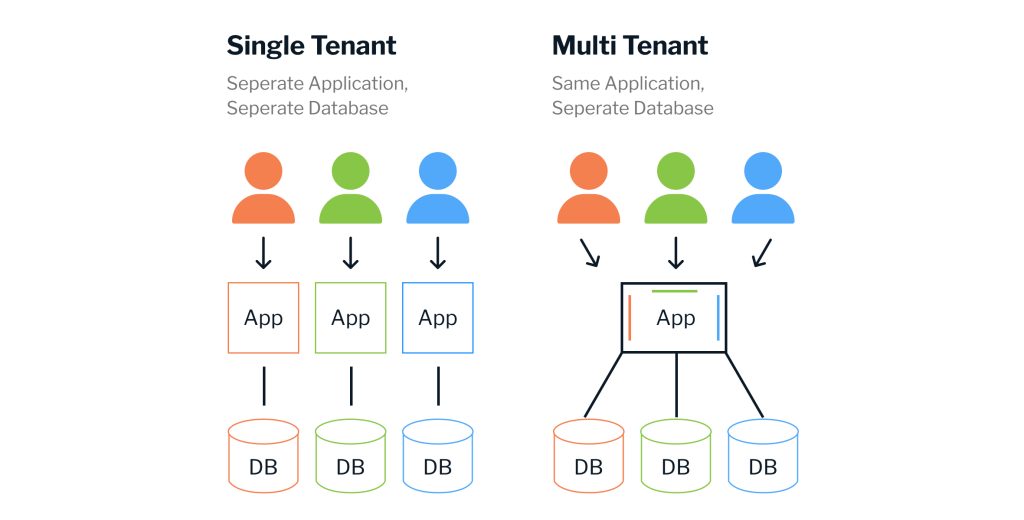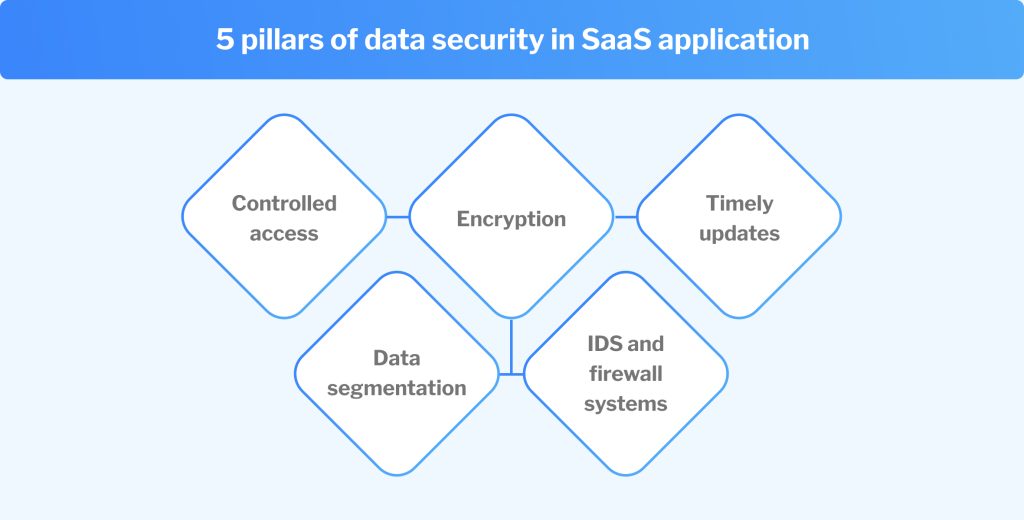We use cookies to ensure we give you the best experience on our website. By clicking Agree you accept our Privacy and Cookies Policy.
How to choose technology stack for SaaS application development

 9 minutes read
9 minutes read
Content
As a business grows, software needs to change and grow with it. For companies that have outgrown their IT staff’s in-house development capabilities or those who simply don’t want to manage the infrastructure themselves, Software as a Service (SaaS) can be an attractive option.
The appeal of SaaS applications is easy to understand: SaaS delivers fast time-to-market, eliminates up-front costs, decreases total ownership expenses, and provides easy scalability. For developers, SaaS makes it possible to build web applications without worrying about setting up or managing servers or middleware infrastructure.
That said, there are several technical aspects to consider before making vital decisions regarding SaaS application development.
Technical aspects of SaaS application development
If you want your SaaS app to succeed, you need to consider various technical details. By thinking through these issues ahead of time, you’ll create a more effective and successful application.
Scalability & performance
One of the most important things to weigh out when building a SaaS application is scalability. When your app is hosted in the cloud, you need to ensure it can manage an ever-growing load of requests. Therefore, you ought to design your system for horizontal scalability, which means adding more resources (such as servers) as needed to meet demand. You also need to ensure that your application can quickly scale up or down depending on usage patterns — you don’t want to be stuck with unused resources when demand drops off.
Another vital consideration to make when building SaaS app is performance. Since users will access your app from all over the world, it should handle high traffic levels without slowing down or becoming overloaded. This includes optimizing your code for performance, using caching mechanisms where possible, and load balancing across multiple servers if necessary.
Multi-tenant database
In multi-tenant architecture, a single application instance serves multiple customers. There are several benefits to using a multi-tenant database architecture:
- Reduced cost. A multi-tenant database can lower costs because you need fewer servers to host the application.
- Increased efficiency. A single instance of the software can serve multiple tenants, leading to increased efficiency and performance.
- Easier management. With a single instance of the software, you only need to manage a single installation rather than multiple installations for each tenant.
- Increased scalability. A multi-tenant database can scale more quickly to accommodate increasing demand because you can add more tenants without affecting existing tenants.

To ensure data security and privacy of customers, SaaS providers utilize different strategies for isolating tenants: pool isolation, bridge model, and tier-based isolation. Each approach has its advantages and disadvantages that need to be considered when initiating SaaS development process.
- Pool isolation. This model uses a shared pool of resources among all tenants. Pool isolation is best suited for applications with a large number of tenants where it would be too expensive to provide separate pools of resources for each tenant. This approach is less costly to scale than dedicated isolation. However, it can lead to contention for resources among tenants if they are not properly managed.
- Bridge model. It uses a proxy server or middleware layer between the tenant’s environment and the back-end systems. This layer provides some degree of isolation by controlling w data and functionality are shared between the two environments while enabling the communication between them to function properly.
- Tier-based isolation. It separates tenants into different tiers based on their subscription plans. This approach can be used with either pooled or dedicated resources. The good thing is that it provides better performance and scalability than the other two approaches since each tier can be scaled independently. On the flip side, it involves more complex configuration and maintenance.
Large cloud service providers such as Amazon Web Services and Microsoft Azure offer these options for tenant isolation. Still, the choice you make depends on your business needs and functional requirements. Consulting with experienced cloud developers will save you time and anticipate pitfalls during this stage of SaaS development.
Guarantees of data security
There is no doubt that cloud computing has become an indispensable tool for businesses of all sizes. The benefits are numerous and include scalability, affordability, and flexibility. But as businesses move more of their data and operations to the cloud, security concerns inevitably arise.
When it comes to ensuring data security in SaaS application development, there is no one-size-fits-all solution. Each business has unique needs and vulnerabilities that must be addressed individually. However, there are a number of best practices that can help businesses ensure that their data is safe and secure in the cloud:
- Control access. One of the most important steps you can take to protect your data is to control its access as tightly as possible. Limit access to authorized users only and use strong authentication measures such as passwords, tokens, or biometric authentication.
- Use encryption. When data is stored or transmitted in the cloud, it should always be encrypted using strong algorithms like AES or 3DES. This will help protect it from prying eyes if it falls into the wrong hands.
- Stay up-to-date. Make sure you keep your software up-to-date with security patches and updates from the vendor. Many cloud providers offer automatic update features, so you can rest assured your software is always up with the latest safety fixes.
- Segment your data. Another way to improve security is by segmenting your data into different categories with different access permissions granted accordingly. This will prevent users from accessing information they are not authorized to see.
- Invest in security solutions. Finally, don’t forget to invest in appropriate security solutions such as firewalls, intrusion detection systems (IDS), and antivirus software that can help protect your data against accidental or malicious breaches. Good to know: many cloud providers offer built-in security solutions.
As sensitive data flows through your system, your number one task is to take care of its security. During SaaS software development, make sure all security aspects are accounted for, from authentication/authorization measures to proper data storage.
Additionally, ensure that any applicable compliance regulations are met or exceeded. For example, if you are located in the European Union, you must comply with GDPR. Similarly, SaaS applications that target the US market need to comply with HIPAA.

SaaS programming language
Here we take a look at some of the top programming languages, find out why they’re so well-suited for building SaaS applications, and explore how you can utilize them in your projects.
.NET is one of the best frameworks for SaaS applications in use today. .NET offers an impressive range of features and capabilities that are ideally suited to developing cloud-based SaaS applications. These include comprehensive support for HTTP services, easy access to data stores such as Azure Tables and NoSQL databases, powerful tools for building asynchronous microservices architectures, and more.
In addition, the growing number of open-source libraries available for .NET development services makes it easy to get started with sophisticated tasks such as machine learning algorithms or AI-powered analytics without having to write any code from scratch.
Another significant advantage of using .NET for SaaS web development is its broad compatibility with other platforms and technologies. For example, many enterprise-grade systems already rely on Microsoft products such as Azure Active Directory or SQL Server, so they can be integrated into a new .NET-based system without too much difficulty. And thanks to its popularity among developers worldwide, there’s a rich ecosystem of third-party components and services to add functionality or improve performance when needed.
Another most commonly used programming language for SaaS development is JavaScript. It is known for its flexibility and ease of use – just a perfect match for web development projects that include front-end, back-end, and creating APIs. This makes JavaScript an ideal choice for building SaaS applications, which typically require a robust and well-rounded feature set.
Due to its popularity, a large community of JS developers can offer support when needed. Also, JavaScript code is easy to read and understand, making it more feasible during coding and subsequent changes/updates. In addition, debugging JS code is very straightforward. All these factors make JS an appealing choice for enterprises seeking long-term stability in their SaaS software solutions.
When working with Javascript in a SaaS context, choosing an appropriate toolkit or library is essential to make your job easier. For example, ReactJS is popular among SaaS software developers because it allows you to create reusable components so that your code is more organized and maintainable.
SaaS integrations
Integrations are always a challenge for SaaS developers. Since different companies use different software, it can be difficult to find common ground on which the two programs can communicate. Moreover, SaaS platforms often have their own unique protocols that complicate integration.
Despite these challenges, there are several ways how to build a SaaS application and successfully integrate third-party applications and services:
- Integration Platform as a Service (IPAAS). Standardized connectors offered by IPAAS providers allow different software programs to work together seamlessly. This is the most efficient way to manage multiple integrations because it centralizes all the communication between apps in one place.
- Application Programming Interfaces (APIs). API solutions allow SaaS software developers to create custom code that bridges the gap between two applications. While this option is more time-consuming and requires more technical expertise, it offers greater flexibility in terms of integrating specific functions from each app into the other.
- Pre-built connectors or adapters. Many commercial connectors are available on the market make it easy for developers to connect two or more SaaS applications without writing any additional code. However, not all connector solutions will fit your purpose, so careful evaluation is necessary before you make a purchase decision.
Regardless of which method you choose to integrate your SaaS applications, there are some critical things to keep in mind.
First – test everything thoroughly. Successful integration depends on accurate data synchronization between both applications, and thorough testing eliminates errors during live operation. Things like API keys, authentication mechanisms, or formatting requirements can often change without warning, causing integration issues down the line. Planning ahead by building mock data during the development or performing QA testing with actual live data will help avoid potential problems.
Second – document everything! As with any software development project, documentation is key – especially when dealing with complex integrations involving multiple apps. If you’re facing an integration challenge and aren’t sure how best to proceed, don’t hesitate to contact us – we’d love to help!
About us
Blackthorn Vision is a SaaS application development company that builds end-to-end applications and augments software teams with dedicated developers. We help companies transform their business processes and gain a competitive edge. Our case studies offer real-life examples of how our products have helped businesses achieve their goals, so check them out!
















